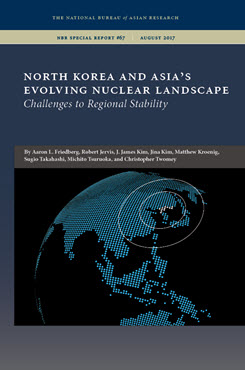Thinking about the Unthinkable
The Case of the Korean Peninsula
This essay examines how North Korea’s potential deployment of nuclear-tipped ballistic missiles could fundamentally transform the geostrategic landscape in Northeast Asia and draws implications for the U.S.-Japan alliance.
EXECUTIVE SUMMARY
This essay examines how North Korea’s potential deployment of nuclear-tipped ballistic missiles could fundamentally transform the geostrategic landscape in Northeast Asia and draws implications for the U.S.-Japan alliance.
MAIN ARGUMENT
North Korea’s potential deployment of nuclear-tipped ballistic missiles would have game-changing effects in Northeast Asia. Traditionally, Japan has been a safe staging area for a Korean Peninsula contingency, as was the case during the Korean War. With nuclear-tipped ballistic missiles, however, North Korea could intimidate Japan into not cooperating with the U.S. Considering the huge strategic benefits for North Korea of intimidation of Japan, the possibility of nuclear blackmail, strikes against military facilities, or even nuclear warning shots should not be excluded. To reassure Japan in that situation, the U.S. should prepare some measures to increase the credibility of extended deterrence and augment the capability to limit any damage. One particular issue is that retaliation-based deterrence does not physically block missile strikes. If the size of North Korea’s ballistic missile arsenal is greater than the number of interceptors defending Japan, the ballistic missile defense system would be exhausted before the attack ends. Thus, the U.S. may need to revisit its nuclear utilization strategy to prevent the launch of nuclear-tipped missiles in the first place.
POLICY IMPLICATIONS
- The U.S. and South Korea should reconfirm Japan’s indispensable role for U.S. military operations on the Korean Peninsula. Given that Japan will face tough decisions in a Korean Peninsula contingency, sharing information about the operational planning process between the U.S.–South Korea alliance and the U.S.-Japan alliance is important.
- Under the threat of nuclear blackmail by North Korea, Japan needs qualitatively and quantitatively upgraded assurance from the U.S.
- In addition to retaliation-based deterrence and missile defense, the U.S. needs to consider the full range of options for damage limitation, including the nuclear option. If it is necessary, the promptest and surest means to destroy global targets, such as intercontinental ballistic missiles, should be on the table to physically prevent North Korea from launching nuclear missiles.
Sugio Takahashi is the Chief of the Policy Simulation Division of the National Institute for Defense Studies in Japan. He was Deputy Director of the Office of Strategic Planning in Japan’s Ministry of Defense from 2008 to 2016. In that capacity, he was a member of the team that drafted the National Defense Program Guidelines in 2010 and 2013.
NOTE: The views expressed in this essay are those of the author alone and do not represent the views of the government of Japan or the National Institute for Defense Studies.


